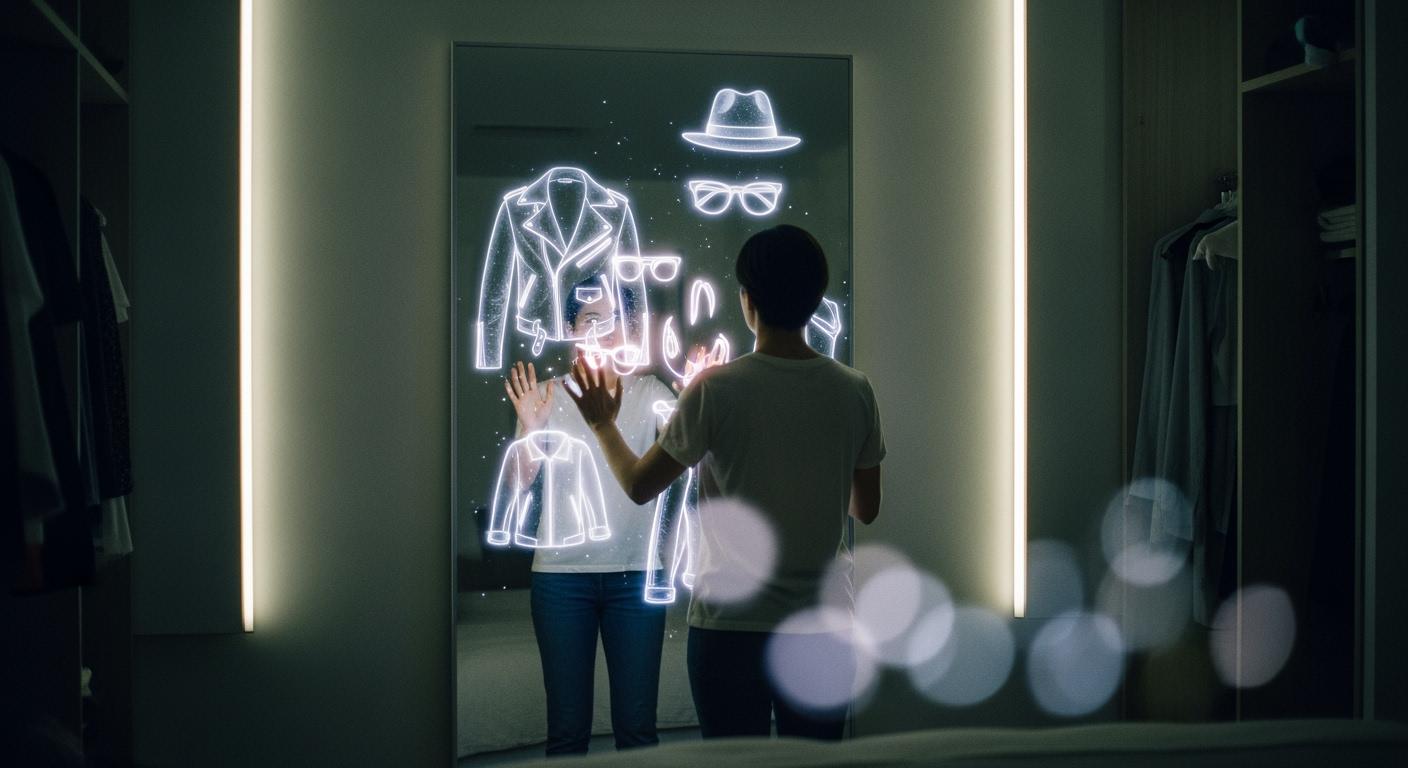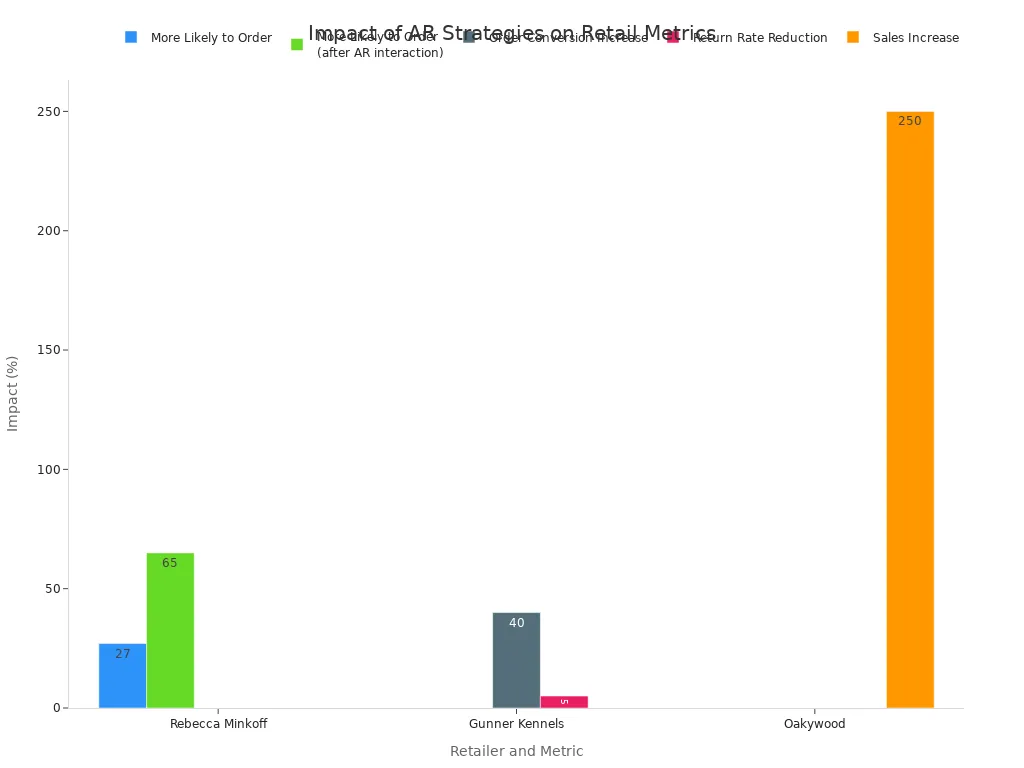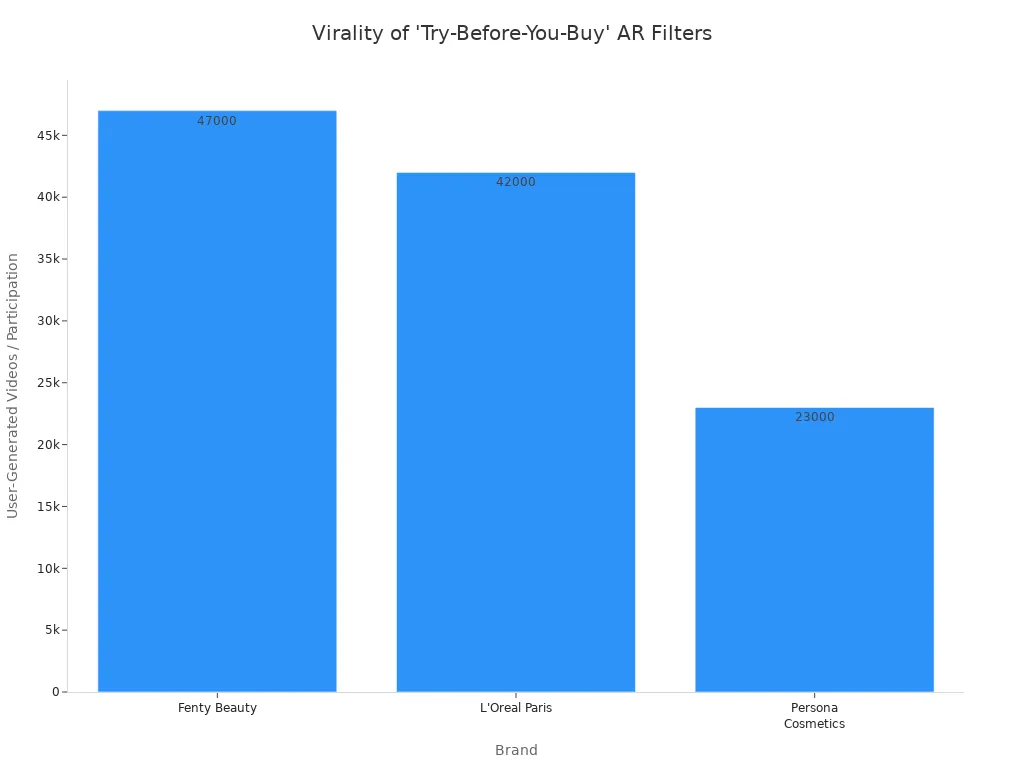
The year 2025 marks a major shift. Augmented reality styling moves from novelty to necessity, reshaping the fashion industry. The key fashion trends 2025 are driven by AR and AI. These digital fashion trends include hyper-realistic virtual try-ons and powerful AI stylists. This integration of technologies makes fashion more interactive and personal. The top trends for 2025 show that digital fashion trends are key.
This trend is gaining traction. Studies show 61% of consumers are more likely to buy from brands using immersive AR. Digital fashion trends also promote sustainability.
Hyper-Realistic Virtual Try-On Technology

Hyper-realistic virtual try-on technology is transforming the fashion landscape. It moves beyond simple 2D overlays. This technology uses a device's camera or an in-store AR mirror to create a live, interactive experience. Advanced algorithms map a user's body precisely. This allows customers to see how clothes fit and move in real time.
Real-Time Fit and Drape Simulation
Modern virtual try-ons use sophisticated machine learning. Deep learning models analyze a user's body shape and predict fabric behavior. This creates a highly realistic virtual fitting. In stores, AR mirrors employ depth cameras and body-tracking software. These tools measure key points like shoulder width and torso length. A physics engine then simulates the virtual garment's drape, ensuring the cloth physics follow the user's movements naturally. This makes the virtual try-ons feel incredibly lifelike.
Photorealistic Accuracy on Mobile Devices
Achieving realism on mobile devices requires advanced rendering techniques. Developers use methods like texture mapping and bump mapping. These create the illusion of 3D detail and surface texture on a flat screen. Accurate light estimation is also critical. The augmented reality software considers real-world lighting to cast realistic shadows and reflections on the virtual clothing. This makes the virtual item blend seamlessly with the user's environment.
Boosting Confidence and Lowering Returns
This technology directly addresses online shopping uncertainty. A realistic virtual try-on helps customers make confident purchase decisions. Luxury watch brand Baume & Mercier uses a mobile virtual try-on for its Riviera collection. The app generates a photorealistic image of the watch on the user's wrist, adapting to real-world light and shadow. This immersive experience boosts confidence for high-value purchases.
Brands that implement AR try-ons see significant benefits. They report an average reduction in product return rates between 20% and 40%.
Better visualization helps customers choose the right products from the start. This reduces the costly cycle of returns and improves overall satisfaction with their virtual fashion experience.
AI-Powered Personal Stylists
Beyond virtual try-ons, 2025 sees the rise of AI-powered personal styling. This technology acts as a smart fashion advisor living inside a user's phone. AI algorithms create a deeply personal and convenient styling experience. This ai driven styling transforms how people discover and assemble outfits. The result is a service that understands individual taste on a granular level, making ai-powered personal styling an essential tool.
Context-Aware Outfit Curation
AI excels at providing suggestions that fit a user's real-world context. The technology analyzes a person's digital calendar to understand their schedule. It suggests professional outfits for work meetings and casual looks for weekend plans. The AI also checks real-time weather data. It recommends lightweight fabrics for hot days or layered outfits for cooler temperatures. This process delivers practical, real-time outfit suggestions. A digital styling app with these ai-powered features can suggest a waterproof jacket for a rainy commute, ensuring users are always prepared.
Hyper-Personalization with User Data
True personalization comes from data. AI systems analyze a wide range of user information to create hyper-personalized recommendations. This data includes:
- Purchase history and browsing patterns
- Items clicked on and time spent on a product page
- Social media activity and style preferences
By understanding these behaviors, the AI learns a user's unique fashion identity. This deep level of personalization helps brands build stronger customer relationships.
Combining AR with AI for personalization can improve customer satisfaction and increase repeat purchase rates by up to 35%.
AI for Personal Style Discovery
AI also helps users discover new fashion possibilities. The system analyzes a user's existing wardrobe and past outfits. It identifies preferred colors, shapes, and styles to build a "style DNA" profile. Based on this profile, the AI suggests new items or outfit combinations that gently push users beyond their comfort zone. For example, it might recommend a new silhouette or color palette that complements what they already own. This interactive process helps people evolve their personal style, turning the AI into a true partner in fashion discovery.
The Growth of Augmented Reality Shopping
Augmented reality shopping is evolving far beyond simple try-on features. In 2025, it reshapes the entire customer journey. This technology creates a more engaging and informative buying process. These digital fashion trends make shopping more interactive and confident for everyone.
Interactive 3D Product Viewers
Interactive 3D product viewers are a powerful tool. They allow customers to see a product from every angle on a website. Users can rotate, zoom, and inspect items in detail. This level of interaction builds a stronger connection to the product than static images can. Brands that use 3D images see conversion rates increase by up to 250%. This AR feature is one of the most effective digital fashion trends for boosting online sales.
Immersive Virtual Showrooms
Brands are now creating immersive virtual showrooms to display their fashion collections. These digital spaces allow customers to explore products in a curated, 3D environment. This creates an immersive fashion experience from anywhere. Luxury brands are leading this trend:
- Gucci and Louis Vuitton use high-tech pop-up stores with AI assistants.
- Chanel creates exclusive virtual boutiques for special collections.
A Deloitte study found that immersive experiences can increase the time people spend on a website by up to five times. This makes virtual showrooms a key part of modern digital fashion trends.
Blurring Lines Between Online and In-Store
The integration of AR blurs the line between online shopping and visiting a physical store. Retailers use technology to connect both worlds. For example, Farfetch uses virtual mirrors in its London store to offer styling advice. This technology enhances the physical shopping trip. Online, Rebecca Minkoff found that customers who interacted with an AR version of a product were 65% more likely to make a purchase. This shows how digital fashion trends are shaping the future of ai shopping. This blend of physical and virtual elements defines the future of ai shopping.

Social Commerce and Augmented Reality Filters

Social media platforms are now powerful retail channels. They use augmented reality to merge entertainment with shopping. These digital fashion trends allow brands to connect with customers in new, interactive ways. The latest trends show that AR filters are essential for modern fashion marketing.
Viral Try-Before-You-Buy Lenses
Brands create viral "try-before-you-buy" lenses on platforms like TikTok and Instagram. These AR filters let users virtually try on makeup, accessories, and other products. This creates a fun, shareable experience. Beauty brands are leading these digital fashion trends. Fenty Beauty's foundation matching filter generated over 47,000 user videos. L'Oreal's brow filter also saw huge engagement. These interactive trends help customers find the right products before they buy.

Instant Product Discovery on Social Media
AR technology on social media shortens the customer journey. Users can discover a product and virtually try it on within the same app. This removes the guesswork from online shopping. Platforms like Snapchat have pioneered AR tools that make shopping more interactive. This technology meets consumer demand for more engaging brand experiences. It streamlines the path from discovery to purchase, making it one of the most effective digital fashion trends.
Driving Brand Engagement and Sales
These digital fashion trends directly boost brand performance. Companies measure the success of AR campaigns with several key metrics.
- Impressions: The total number of views.
- Captures: The number of users who record a photo or video.
- Shares: How many times users share the AR effect.
- Dwell Time: The average time a user interacts with the filter.
- Conversions: The percentage of users who make a purchase.
Data shows that users spend an average of 75 seconds with an AR experience, which is nearly double the time spent on traditional video. This increased engagement often leads to higher sales and stronger brand loyalty.
Impact Snapshot: AR Styling vs. Traditional Methods
Augmented reality styling creates a clear impact when compared to traditional shopping. The technology offers measurable improvements in customer confidence, operational efficiency, and sustainability. These advancements show why AR and ai are becoming essential tools in the fashion industry.
Purchase Confidence Comparison
Traditional online shopping often leaves customers uncertain about fit and appearance. AR technology directly solves this problem. It allows shoppers to visualize products on themselves before buying. This interactive preview builds a strong sense of confidence. Customers make more informed decisions, which leads to greater satisfaction with their purchases.
Return Rate Reduction
High return rates are a major challenge for online retailers. The average return rate for online apparel in the US is 24.4%. AR styling helps lower this number significantly. For example, one online store, UrbanStyle Trends, reduced its return rate from 35% to 25% after adding a virtual fitting tool. Better visualization ensures customers choose the right items the first time.
Personalization and Engagement Levels
AR and ai technologies create a far more engaging and personal shopping journey. Unlike static websites, these tools offer a dynamic experience.
- They provide realistic product previews and high interactivity.
- The technology acts as a shopping guide with personalized suggestions.
- Users can customize product attributes like color and size in real time.
- An ai system can analyze shopping history to recommend customized products.
This immersive experience holds user attention longer and builds a stronger connection between the customer and the brand.
The Sustainability Advantage
The fashion industry produces over 92 million tons of waste annually. AR styling offers a powerful solution to improve sustainability. By simulating fit and style digitally, the technology reduces the need for physical samples. This directly lowers production waste. Brands like Zara have used an ar app to reduce returns by 15%. This shift toward digital visualization supports a more responsible and efficient fashion ecosystem.
The Future of Augmented Reality Styling
The future of augmented reality styling looks even more integrated into our daily lives. The fashion trends 2025 are just the beginning. Technology will soon offer on-the-go advice and predict what we want to wear next. This evolution points toward a smarter future of ai shopping. The year 2025 sets the stage for these exciting digital fashion trends.
On-the-Go Styling with Smart Glasses
Smart glasses will bring styling advice directly into a user's field of view. These devices will offer instant fashion feedback and visualization anywhere. A digital styling app on smart glasses could suggest outfits or accessories in real time. The future of ai shopping involves this kind of immediate, hands-free interaction. Several companies are developing glasses perfect for this augmented reality experience.
| Model | Key Features for AR Styling |
|---|---|
| Ray-Ban Meta Glasses | Stylish frames with a high-resolution camera and AI assistant. |
| XREAL Air 2 Ultra | Lightweight frames with a high-quality screen and motion tracking. |
| Solos AirGo 3 | Comfortable frames with ChatGPT integration for advice. |
| Vuzix Z100 | Clear screen for notifications and simple gesture controls. |
Digital Twins for Physical Apparel
Digital twins are highly detailed virtual copies of physical garments. Designers create these models using special software. They build digital patterns, apply virtual fabrics, and simulate how the clothing fits on an avatar. This technology is a core part of the digital fashion trends for 2025.
These virtual twins allow customers to try on and customize items with incredible realism. Brands can show off new fashion collections without making physical samples. This process speeds up design and reduces waste.
This technology is a key part of the future of ai shopping. It makes the digital fashion trends more interactive and personal. A digital styling app can use these twins to provide a better experience.
Predictive AI Trend Forecasting
AI is becoming a powerful tool for predicting fashion trends. This technology analyzes huge amounts of data to see what styles will be popular. The ai outfit forecasting process helps brands make smarter decisions. This trend is a major part of the fashion trends 2025. The ai outfit forecasting process follows several key steps:
- Defining Audiences: AI first segments social media users into groups like trendsetters and early adopters.
- Applying Computer Vision: The technology scans millions of images to detect attributes like colors, prints, and shapes.
- Utilizing Machine Learning: AI algorithms analyze this data to predict how trends will evolve.
- Providing Insights: Brands receive forecasts to guide their design and production choices.
Companies like Zalando and H&M already use ai to understand customer preferences and optimize their supply chains. This technology is shaping the digital fashion trends for 2025 and beyond.
In 2025, ai and ar are essential tools. These technologies are no longer futuristic concepts. The key digital fashion trends empower consumers.
The top trends for 2025 deliver a more personal and sustainable fashion experience. These digital fashion trends are key trends.
AI helps shape these digital fashion trends and other emerging fashion trends. These digital fashion trends permanently reshape our relationship with fashion. These digital fashion trends are the future.
FAQ
What is augmented reality styling?
Augmented reality styling uses technology to place virtual items onto a person's body. Users see how clothes or accessories look in real time through their device's camera. This technology helps people make confident shopping decisions from anywhere.
How does an AI personal stylist work?
An AI personal stylist analyzes user data. This data includes purchase history, style preferences, and calendar events. The AI then recommends personalized outfits. It acts as a smart fashion advisor, helping users discover new styles and create looks.
Can AR technology help the environment?
Yes, AR styling promotes sustainability. ♻️ It reduces the need for physical product samples, which lowers production waste. Confident purchase decisions also lead to fewer product returns. This process creates a more efficient and responsible fashion industry.
What is a digital twin in fashion?
A digital twin is a detailed virtual copy of a physical garment. Designers create these 3D models to test fit and style without making a real sample. Customers can then try on these digital twins virtually, creating a realistic and interactive experience.
See Also
Sustainable AI Innovations: Revolutionizing Fashion for a Greener Tomorrow
Optimizing Fashion Retail: Dynamic AI Safety Stock for 2025 Success
Forecasting Fashion Trends: Predictive AI Models for 2025 Retail
Transforming Supply Chains: AI Sensor Impact on 2025 Fashion Logistics